19/02/15 - Gas Gas TXT 300 Pro Racing vs Sherco 300 ST
The first couple of bikes we tested are the two Spanish’s that boast the longest life (Montesa is with Honda now) and whose respective top riders occupy the second and third place in the world rankings. The choice was dictated and later confirmed by the many little things in common: we are talking about Gas Gas and Sherco. The test was carried out in a winter Sunday with low temperatures: between 6 and 10 degrees. We used the authorized area belonging to BM Racing, Trials dealer from Bricherasio, near Turin. About what the Testing Team consists of, please click here.
GAS GAS
Celebrating its thirty years of production the factory of Gerona has decided for Trial to focus on a single set-up: the professional, who goes by the name of TXT Pro Racing. It was abandoned the production of the more amateur model , used by those with no competitive ambitions. So only extreme trial bike for those who really want to enjoy the emotions experienced by top riders. As per tradition, the new model follows the Raga replica of the previous year, the one that comes out in limited production in the spring. Just because thanks to the experience on the race, it is possible continuously to improve performance and reliability. Forcibly abandoned the battle of weight due to the minimum limit imposed by the Federation, efforts to offer products always live up to expectations focused in other areas.
The frame is tubular in chrome-molybdenum, with tank inside. Changes since the last version have been a few. There is a new wiring loom with smaller connectors and less cable length. The ignition and the servicing and the magneto flywheel can be done independently via two watertight connectors located in the engine area. There is a new voltage regulator, and a new more functional electric fan, done by SPAL. Also new is the water pump. Even Marzocchi forks now have a new spring. The hydraulic mono shock Reiger has extension and adjustable spring preload.
To complete the chassis a new handlebar, new grips and handlebar protection. Back to Michelin X11 as tires,, after having mounted the X-lite in the past year. Then there are the footrests, the flywheel cover, the front brake calliper, the sprocket, modified to comply with the new FIM rules. In the engine it is also changed the kick-start pedal, the exhaust pipe connection and the intake manifold.
We tried the model 300 cc as displacement, but the substantial same bike is also offered with 80cc, 125cc, 250cc, and 280cc.
The importer is still FG distribution of Susa (TO).
SHERCO
In Sherco the flagship model remains the 300ST, also available in displacements of 290,250,125 and 80cc, and we got one available thanks to the importer, Planet Trial of Alpignano (TO).
The 2015 version features a silencer revised inside, clutch plates by Surflex, the composition of the frame now 100% chrome-molybdenum, a new suspension tuning and a reprogramming of the ECU. They also worked to optimize the thermodynamics. On these models what it leaps out is the rather unusual position of the tank in the middle of the fender. No doubt about the regularity inflow of gasoline. Thanks to a depression of pulses obtained directly from the crankcase as well as improving the functioning of the by-pass and back to the fuel tank in excess, the carburettor Kehin always receives the gasoline it requires.
RIDING
Both our bikes are fitted with a carburettor Keihin PWK 28. Pulling the air lever up, easily accessible, both Gas Gas and Sherco responded well starting at the first try despite the cold of this winter morning. Obvious that the hit on the kick-start pedal must be decisive and strong. A little more effort is required by the Gas Gas, which mounts a shorter pedal. The clutch works well even when it is cold, so the start does not hold surprises. Riding them standing up is really something natural, having both very thin lines of the central frame , which allows the rider to shift his weight easily, without taking positions that may tire in the long.
GAS GAS
On the Gas Gas, there is a super ready throttle response. We recommend to spend few time on easy slopes, before choosing challenging obstacles. In fact, the very reactive suspension, combined with an exaggerated power, easily allow to be pushed even further the obstacle you want to overcome. Anyway the bike is very well balanced and it is necessary to struggle for regaining the balance after passing a stone and (Regulation permitting) you stop for positioning well before tackling the next one. The feeling of lightness does not abandon us even in the mixed terrain, but here suspensions calibrated to climb vertical walls do not help to keep the bike glued to the ground. Because you can easily adjust the setting of the spring , we recommend more moderate users to leave the mono more restrained. You have to ride quite behind for not loosing the grip, but soon you get used. Also thanks to the lightness of the front, you can easily play with semi-volee and sudden changes in direction, being careful not to overdo the throttle opening. You can choose between two positions of the mapping, Rain and Sun, just to distinguish between the slimy, where it is required a greater sweetness, and the dry land where it is possible to use the maximum power. In our view the difference is almost imperceptible. Good behaviour in the steep descents, made even blocking the rear wheel. You always manage to control and direct well your bike where you want. The brakes are powerful and efficient.
SHERCO
The start with the Sherco is softer and seems less powerful, but the engine responds well and revs go up with excellent progression. Although the gear has only five speeds, the first three’s are short enough to let them be chosen in all kind of sections. Due to the choice of moving the tank in the rear part of the tubular frame, which lights a lot the front, there is an ease in wheeling. The clutch is - as befits these extreme models – “ on-off”, so do not particularly popular for amateur use, but to our objection, the importer Renato Chiaberto immediately reassured us by saying that with a change to the plates’ springs, you can get a softening. We were favourably impressed by the work of the pump which sucks the fuel from the tank, necessary in the strong climbs the carburettor would be higher compared to the tank. No faintness and dispensing fluid and always proportionate to the throttle. Very well in mixed route, as the ascent of a small stream, where the suspensions and the elasticity of the engine help a lot. Also thank to the lightness it is very easy moving the front. The two positions of the mapping, S (soft) and H (hard) ,also here, let make a distinction according to the type of terrain. But the differences are very slight. No problem with the brakes even in steep slopes, they are always okay and it’s always easy to address the bike in the desired direction.
CONCLUSIONS
In conclusion which of the two we liked more? Always difficult and subjective judgments to bikes of this level. Who must choose between Gas Gas and Sherco has already himself made a precise reasoning of the type of use that is going to do. These bikes - according to what they were designed for - are ready for competitions and for training tough to try and try again the "sections". We know that there is' a huge clientele that also used the mountain touring or “mulatrial”, today in great expansion in Italy. To these people we can only recommend a calibration down, 'cause both bikes are very ready to every small throttle opening. As powerful it seemed that the Gas Gas can excel. As a guide in the slimy, we indicate the Sherco as favorite. So if the young’s can be more attracted by the exuberance of some horse-powers more , the old’s do not care about having more power, if this increases the difficulty in handling it. But as confessed Andrea Tron, who has been in charge of managing the trial team for the importer Gas Gas in Italy. "Every trial bike can be made more or less aggressive depending on customer needs."
So at this point the choice between the twos becomes almost a matter of old loyalty to a brand or convenience for assistance or still fondness towards one or the other dealer.
------------------------------------------------------------------------------------------
La prima coppia di moto che siamo andati a testare sono le due spagnole che vantano la maggiore anzianità e i cui rispettivi piloti di punta occupano la seconda e terza piazza nella classifica mondiale. La scelta e’ stata dettata e poi anche confermata da tante cosette in comune: stiamo parlando di Gas Gas e Sherco. La prova e’ stata effettuata in una domenica d’inverno con temperature basse tra i 6 ed i 10 gradi. Siamo stati nell’area autorizzata della concessionaria BM Racing di Bricherasio. Su come e' formato il Testing Team vi chiediamo di cliccare qui.
GAS GAS
Per festeggiare i trent’anni di produzione, la Casa di Gerona ha deciso per il Trial di concentrarsi su un unico allestimento: quello professionale, che va sotto il nome di TXT Pro Racing. E’ stata abbandonata la produzione del modello più amatoriale, usata da chi non nutriva ambizioni agonistiche. Dunque moto da trial estremo per chi veramente vuole gustarsi le emozioni vissute dai piloti di vertice. Come da tradizione, il modello nuovo ricalca la “Raga replica” dell’anno precedente, quella che esce in produzione limitata in primavera. Proprio perché grazie all’esperienza maturata sui campi di gara, si possono continuamente migliorare le prestazioni e l’affidabilità. Abbandonata forzatamente la battaglia del peso, per il limite minimo imposto dalla Federazione, gli sforzi per offrire un prodotto sempre all’altezza delle aspettative si sono concentrati in altri settori.
Il telaio è del tipo perimetrale in cromo-molibdeno, con serbatoio incastrato. Le modifiche effettuate sull’ultima versione sono state diverse. L’accensione e’ passata da corrente alternata a corrente continua. C’e’ un nuovo regolatore di tensione, ed un nuovo elettroventilatore , della SPAL più funzionale. Nuova anche la pompa dell’acqua. Anche le forcelle Marzocchi hanno ora una nuova molla ed un nuovo tampone idraulico. Ritoccato anche il tampone idraulico di estensione del mono-ammortizzatore Reiger.
Completano la parte ciclistica un nuovo manubrio , nuove manopole e protezione manubrio. Sui pneumatici si e’ tornati alle Michelin X11, dopo aver montato le X-lite l’anno passato. Poi ci sono le pedane, il coperchio del volano, la pinza del freno anteriore, la corona modificata per aderire alle nuove norme FIM. Nel motore e’ cambiata anche la leva della messa in moto, la curva della marmitta ed il collettore di aspirazione.
Abbiamo provato il modello di 300 cc come cilindrata, ma la stessa moto viene anche offerta con 80cc, 125cc,250cc, e 280cc .
L’importatore e’ sempre la FG distribution di Susa (TO). Il prezzo su strada e' 7300 euro.
SHERCO
Per la Sherco il modello di punta rimane sempre la 300ST, disponibile anche nello cilindrate 290,250,125 ed 80cc, e noi ne abbiamo avuta una a disposizione dall’importatore Planet Trial di Alpignano (TO).
La versione 2015 propone un silenziatore rivisto al suo interno, dischi frizione Surflex , la composizione del telaio ora al 100% in cromo-molibdeno , una nuova regolazione delle sospensioni ed una nuova programmazione della centralina elettronica . Hanno anche lavorato per ottimizzare la termodinamica. Su questi ultimi modelli della Sherco balza subito all’occhio la posizione alquanto insolita del serbatoio nella parte posteriore con tappo ora a metà del parafango. Nessun dubbio sulla regolarità dell’afflusso della benzina. Grazie ad un sistema di depressione di impulsi ottenuta direttamente dal carter, nonchè migliorando il funzionamento del by-pass e ritorno al serbatoio del carburante in eccesso, il carburatore Keihin riceve sempre la benzina di cui necessita. Viene venduta a 7244 euro.
IN MOTO
Entrambe le nostre moto montano un carburatore KEHIN PWK 28. Tirando in alto la levetta dell’aria facilmente raggiungibile, sia la Gas Gas che la Sherco hanno risposto bene con una partenza al primo colpo nonostante il freddo di questa mattinata d’inverno. Ovvio che il colpo sulla pedivella d’accensione deve essere deciso e forte. Un piccolo sforzo in più lo richiede la Gas Gas, che monta una leva più corta. La frizione stacca bene a freddo in tutte e due, per cui la partenza non ci riserva sorprese. Guidarle in piedi è veramente qualcosa di naturale, viste la linee molto magre del telaio centrale, che consente al pilota di spostare il peso agevolmente, senza assumere posizioni che alla lunga possono affaticarlo.
GAS GAS
Nella Gas Gas, c’è una risposta del gas, sembra un gioco di parole, super pronta. Consigliamo di impratichirsi un po’ su facili pendii, prima di scegliere ostacoli impegnativi. Infatti le sospensioni molto reattive, unite ad una potenza esagerata, consentono agevolmente di venire spinti perfino oltre all’ostacolo che si vuole superare. Comunque la moto è molto ben bilanciata e non si fatica a riprendere l’equilibrio dopo aver superato un masso e (regolamento permettendo) ci si deve fermare per partire bene ed affrontare quello successivo. La sensazione di leggerezza non ci abbandona neanche nei percorsi misti dove però sospensioni tarate per essere sparati a molla sui muri verticali, non aiutano a tenere la moto incollata a terra. Siccome si può facilmente intervenire sulla regolazione della molla, consigliamo utenti più moderati di regolare il mono più frenato. La moto si deve guidare molto indietro per non perdere l’aderenza, ma ben presto ci si abitua. Inoltre grazie alla leggerezza dell’avantreno, si può facilmente giocare con semi-volee e cambiamenti di direzione improvvisi, a patto sempre di non esagerare con l’apertura del gas. Si può scegliere fra due posizioni della mappatura, fra Rain (pioggia) e Sun (sole), giusto per distinguere fra il viscido, dove si esige una maggiore dolcezza, e l’asciutto dove si può pretendere il massimo della potenza. A nostro avviso la differenza e’ quasi impercettibile. Ottimo il comportamento nelle ripide discese, fatte bloccando anche la ruota posteriore. Si riesce sempre a controllare ed indirizzare bene il mezzo dove di vuole. I freni sono potenti ed efficienti.
SHERCO
La partenza con la Sherco è più dolce e sembra meno potente, ma il motore risponde bene e prende comunque i giri con un’ottima progressione. Anche se il cambio ha solo 5 marce, le prime tre sono sufficientemente corte da poter essere usate nella maggior parte delle zone controllate. Dalla scelta di spostare il serbatoio nella parte posteriore del telaio perimetrale, che alleggerisce di molto l’anteriore, si avverte una facilità nell’effettuare gli spostamenti della ruota davanti. La frizione è come si addice in questi modelli estremi, del tipo on-off, quindi non particolarmente apprezzata per un uso amatoriale, ma alla nostra obiezione, l’importatore Renato Chiaberto ci ha subito rassicurato affermando che con una modifica alle molle dei dischi, si può ottenere un addolcimento. Impressiona favorevolmente il lavoro della pompa che risucchia la benzina dal serbatoio, necessaria per quando nelle forti pendenze in salita il carburatore si troverebbe più in alto rispetto al serbatoio. Nessun mancamento ed erogazione sempre fluida e proporzionata all’apertura del gas. Molto bene nel percorso misto, come la risalita di un torrentello, dove le sospensioni e l’elasticità’ del motore aiutano molto. Anche molto facile lo spostamento dell’avantreno, vista la leggerezza. La due posizioni della mappatura S (soft) e H (hard) consentono anche qui di fare un distinguo a seconda del tipo di terreno. Ma non ci e’ sembrato che le differenze siano molto sensibili. Nessun problema nei discesoni con freni sempre all’altezza e facilità nel far correre le moto nella direzione voluta.
CONCLUSIONI
Insomma in conclusione quale delle due ci è piaciuta di più? Sempre difficile e soggettivo un giudizio per moto di questo livello. Chi deve scegliere fra Gas Gas e Sherco ha già di per se’ fatto un preciso ragionamento del tipo di utilizzo che andrà a fare del suo mezzo. Così come sono state progettate sono moto pronte per le competizioni e per gli allenamenti finalizzati a provare e riprovare le “zone” . Sappiamo che c’e’ una grandissima clientela che la usa anche per il motoalpinismo o le mulatrial, oggi in grande espansione nel nostro Paese. A questi possiamo solo consigliare una taratura verso il basso, perché entrambe sono moto molto pronte ad ogni piccola apertura del gas. Come potenza ci e’ sembrato che la Gas Gas possa primeggiare. Come guida nel viscido, indichiamo la Sherco come favorita. Insomma se il giovane può venire maggiormente attratto dall’esuberanza di qualche cavallo in più, al vecchio il cavallo in più non fa gola se gli aumenta la difficoltà nel gestirlo. Ma come ci confessa Andrea Tron, da anni responsabile del Trial per l’importatore Gas Gas in Italia. “Ogni moto da Trial può essere resa più o meno cattiva a seconda delle esigenze del cliente”.
Dunque a questo punto la scelta fra le due diventa quasi una questione di antiche fedeltà ad un marchio o di comodità per l’assistenza o, ancora, di simpatia verso uno o l’altro concessionario.




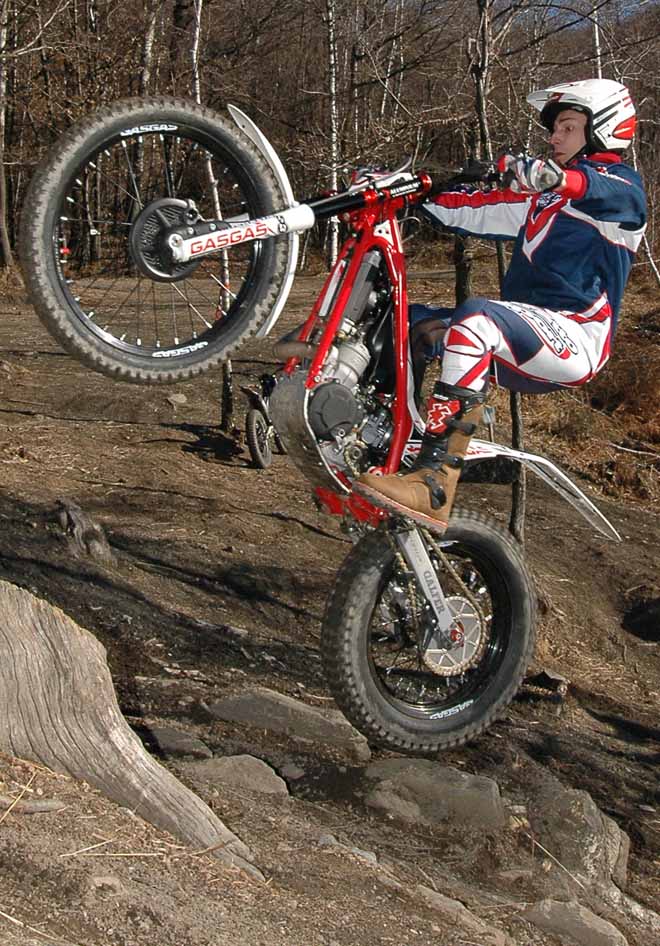
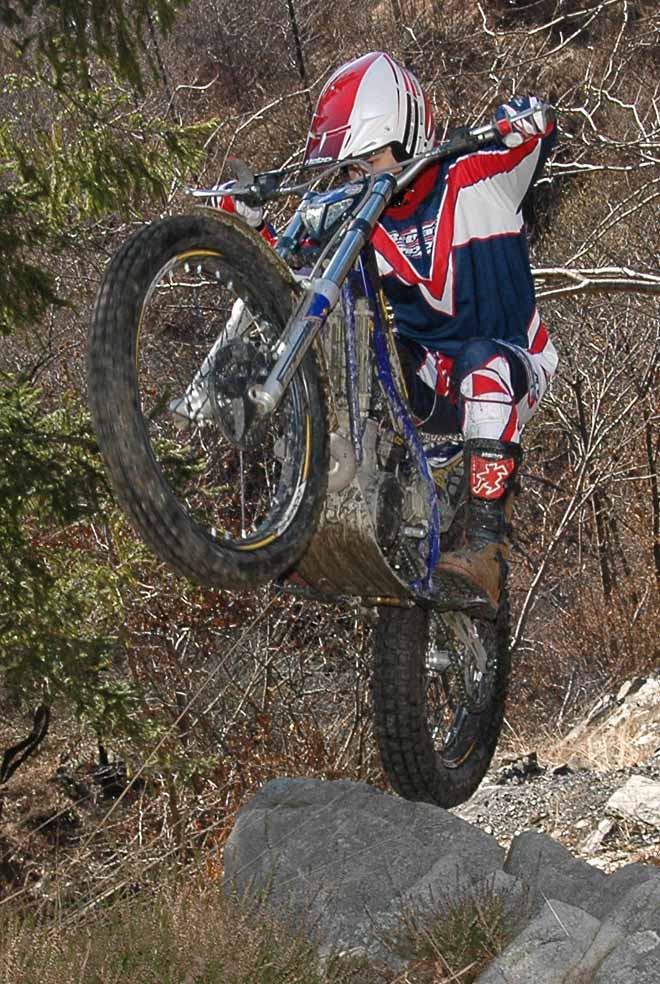
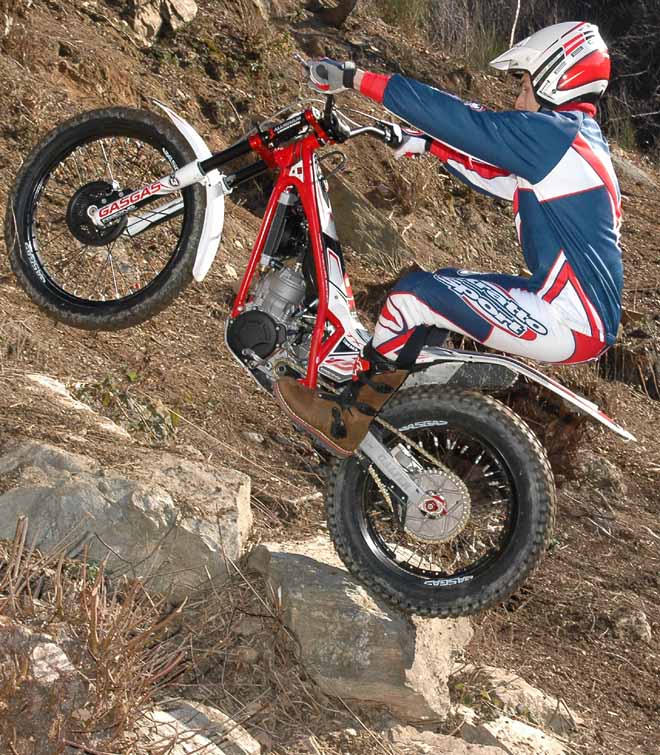
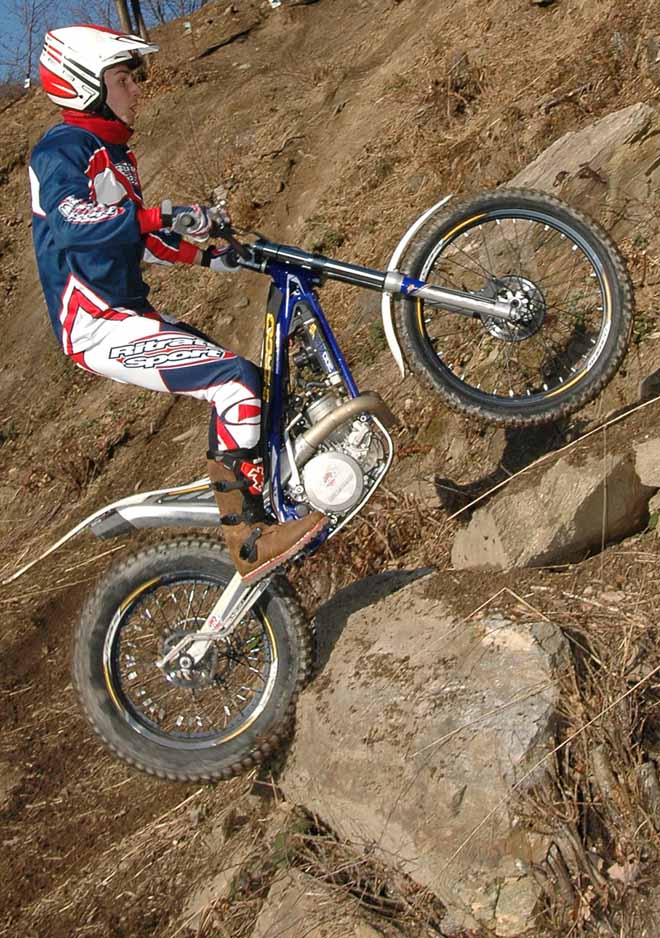
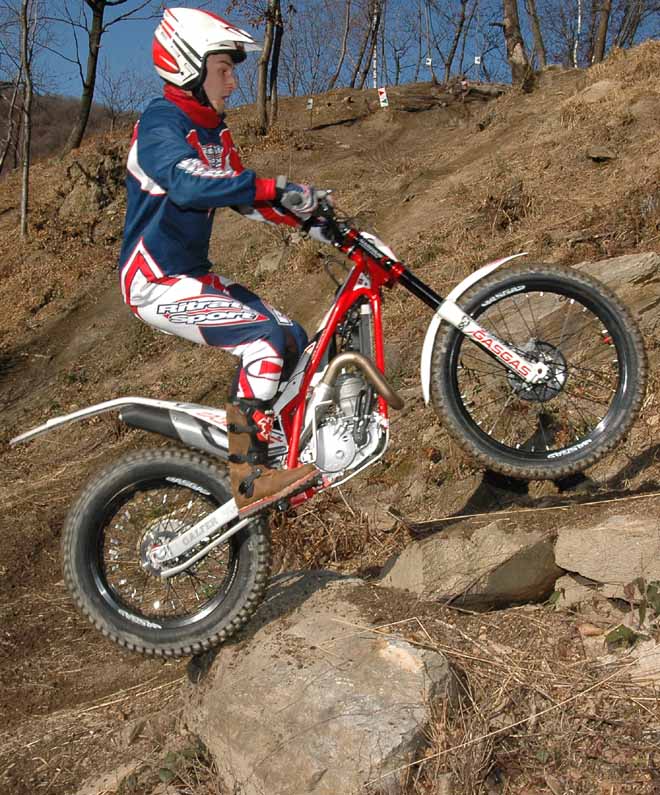
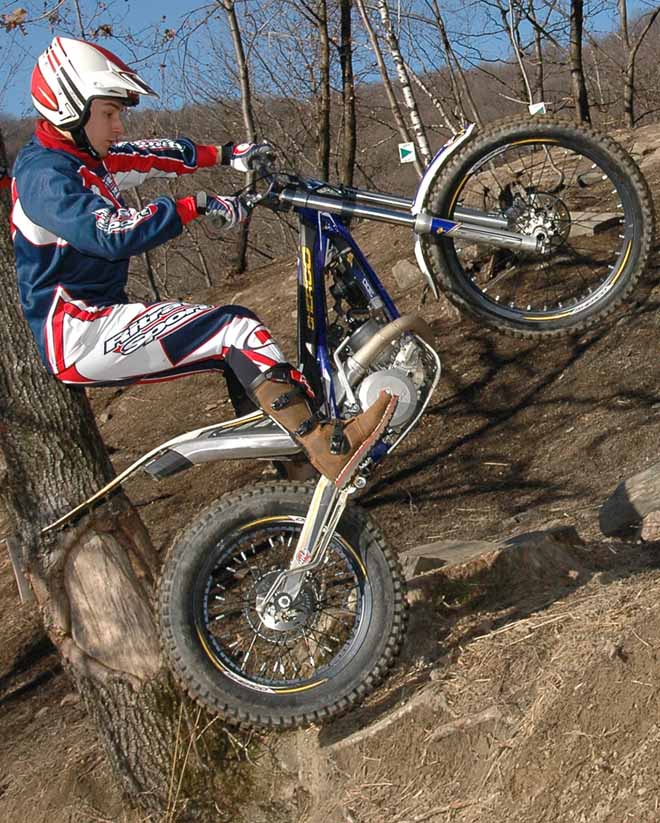
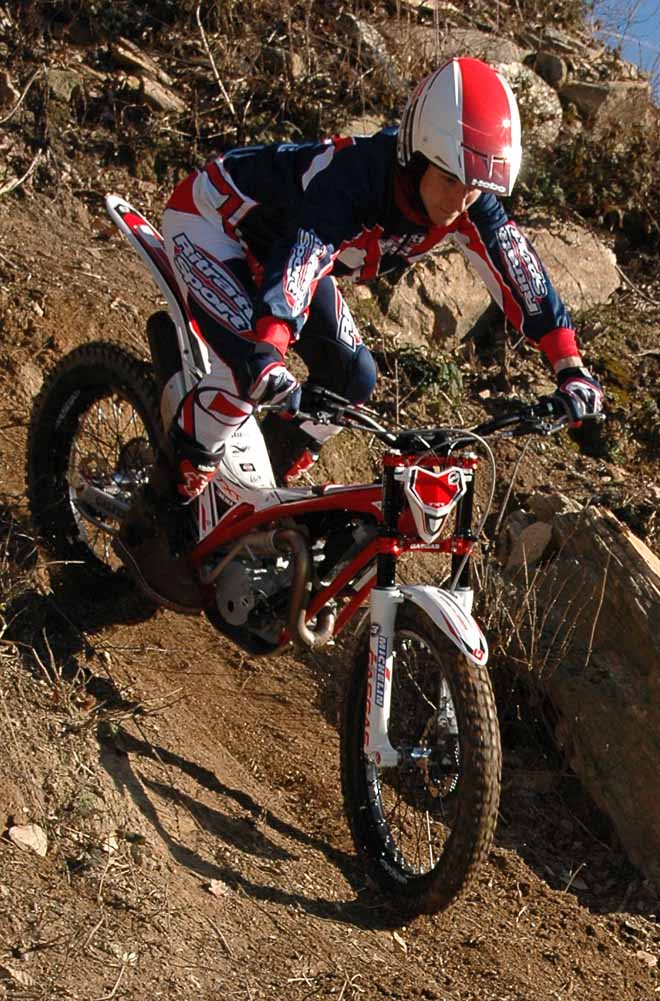
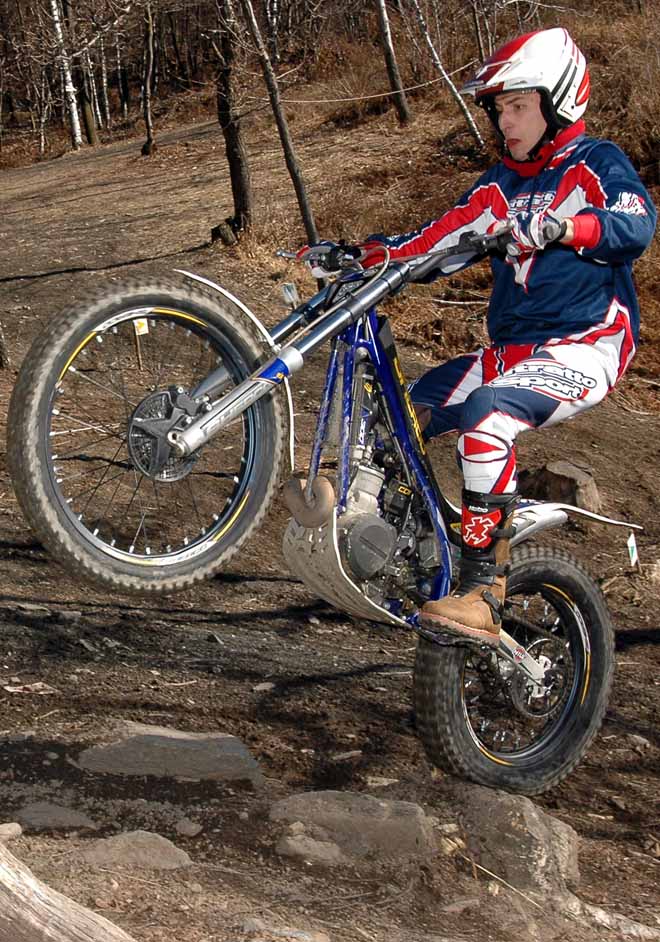
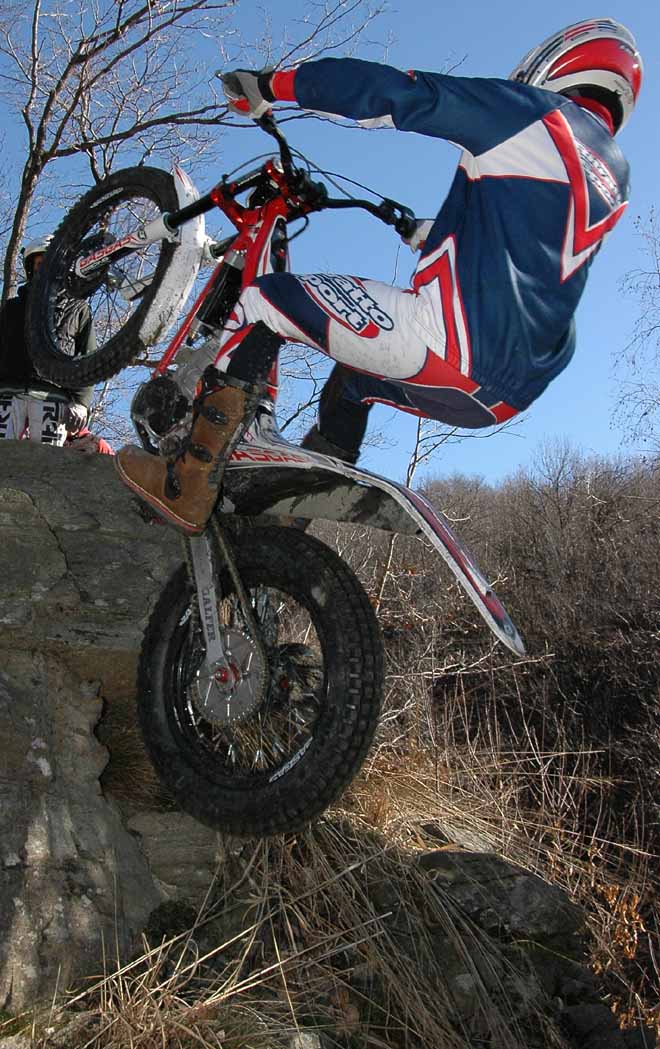
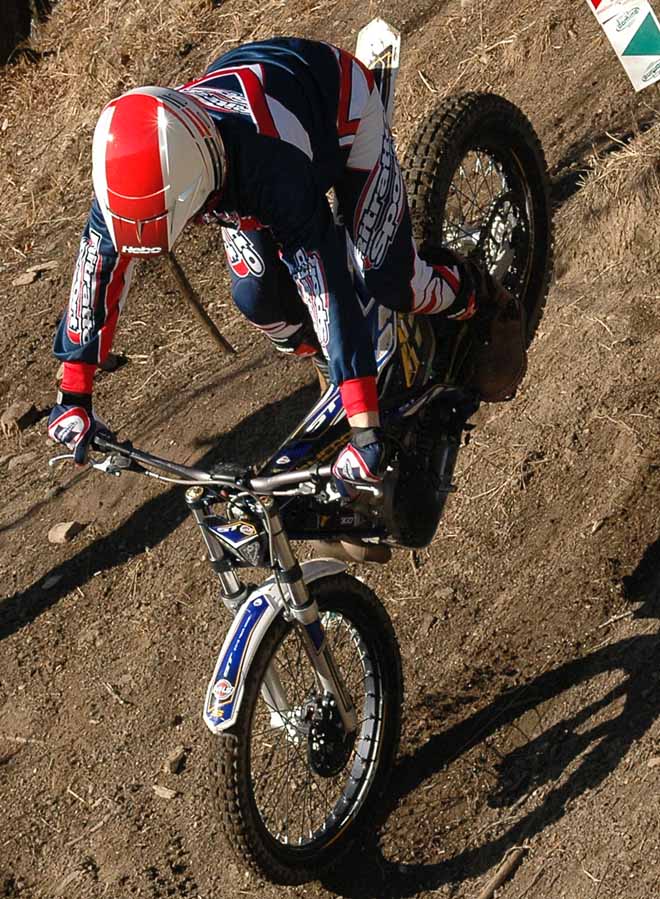
------------------------------------------------------------------------------------------
------------------------------------------------------------------------------------------
------------------------------------------------------------------------------------------
| GAS GAS | SHERCO | |
| motore / engine | 2 tempi raffreddato acqua / 2t liquid cooler | 2 tempi raffreddato acqua / 2t liquid cooler |
| cilindrata / displacement | 294,1 | 294 |
| alesaggio x corsa / bore x stroke | 79 x 60 | 79 x 60 |
| accensione / ignition | HIDRIA | HIDRIA |
| carburatore / carburettor | KEIHIN PWK 28 | KEIHIN PWK 28 |
| lubrificazione / lubrification | miscela 2% | miscela 2% |
| frizione / clutch | idraulica/hydraulic BRAKTEC | idraulica/hydraulic BRAKTEC |
| trasmissione / trasmission | 6 marce/speed | 5 marce/speed |
| telaio / frame | perimetrale CrMo/tubular CrMo | perimetrale CrMo / tubular CrMo |
| forcelle / forks | MARZOCCHI 40/177 | TECH 39/165 |
| forcellone / swingarm | alluminio, sistema progressivo con link/ aluminium, progressive system with linkage | alluminio, sistema progressivo con link/ aluminium, progressive system with linkage |
| reg. forcelle / forks adjiust. | compressione e ritorno/ compression and rebound | compressione e ritorno/ compression and rebound |
| mono / monoshock | REIGER hydraulic (2 ways) | R18V 175 mm |
| reg. mono / mono adjust. | estensione e caricamento molla/extension and spring preload | estensione e caricamento molla/extension and spring preload |
| cerchi / rims | MORAD | MORAD |
| gomma anter. / front tyre | MICHELIN comp. 2,75 x 21 | MICHELIN comp. 2,75 x 21 |
| gomma post. / rear tyre | MICHELIN X11 4,00 x 18 | MICHELIN X11 4,00 x 18 |
| freno anter. / front brake | BRAKTEC disc 185 mm | BRAKTEC disc 185 mm |
| freno poster. / rear brake | BRAKTEC disc 150 mm | BRAKTEC disc 145 mm |
| serbatoio / tank | litri 2,4 | litri 2,7 |
| peso a secco / dry weight | 66 kg | 68 kg |
| interasse / wheelbase | 1320 mm | 1325 mm |
| altezza sella / seat height | 630 mm | 645 mm |
| luce da terra / ground clearance | n.d. | 310 mm |

